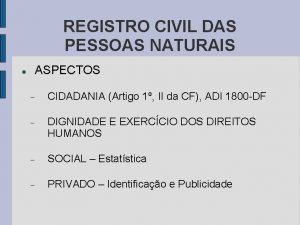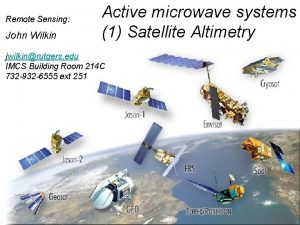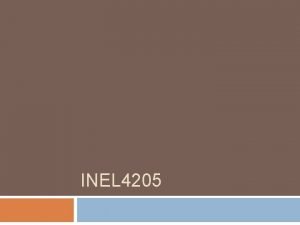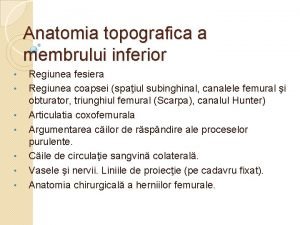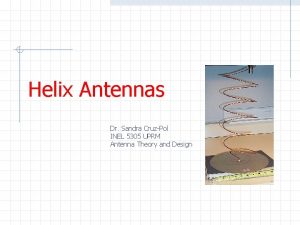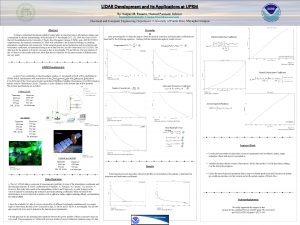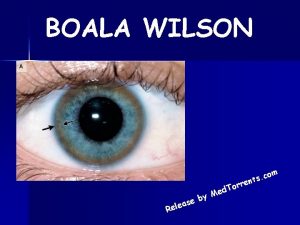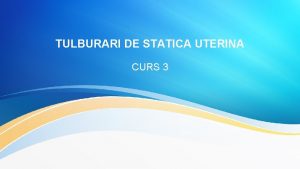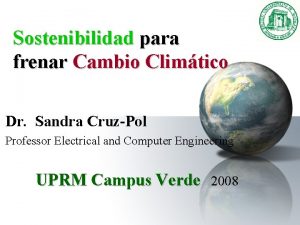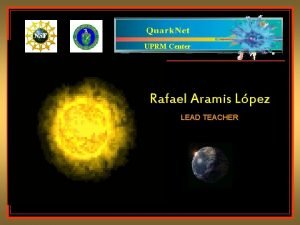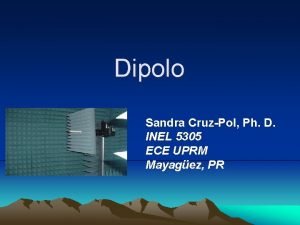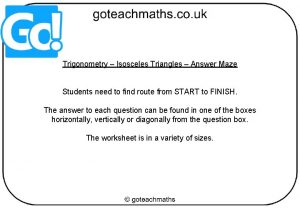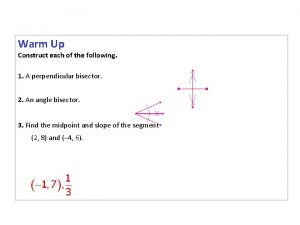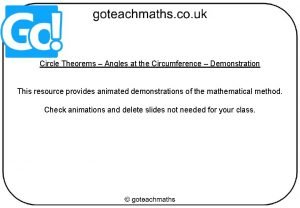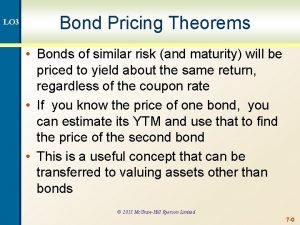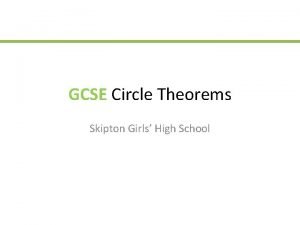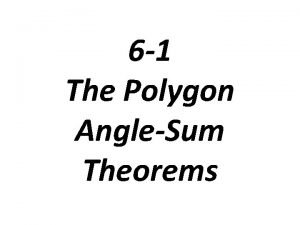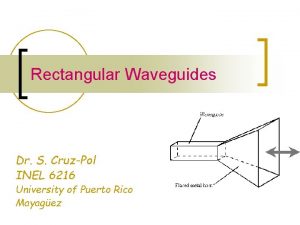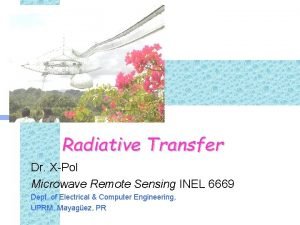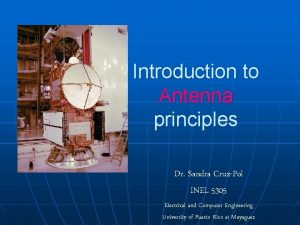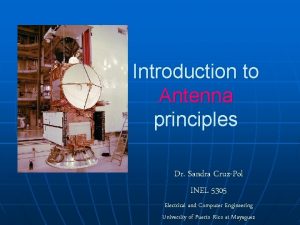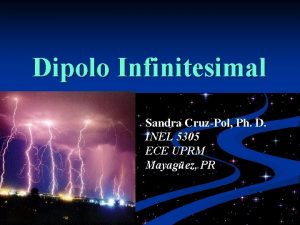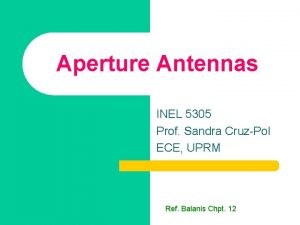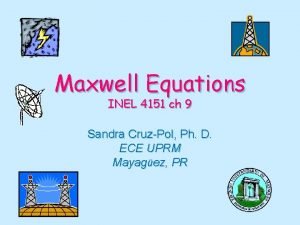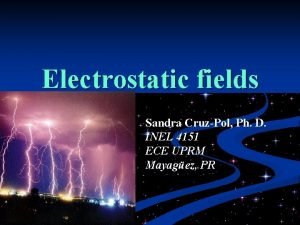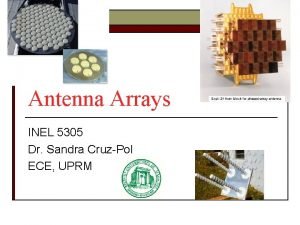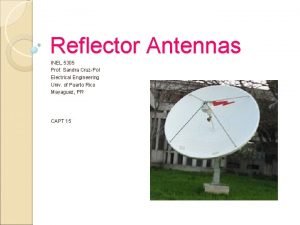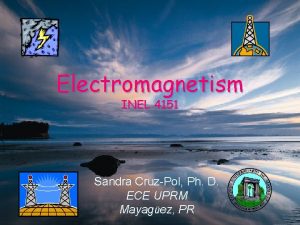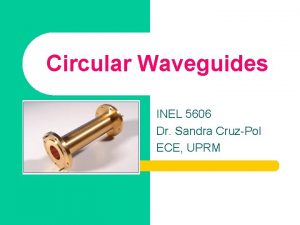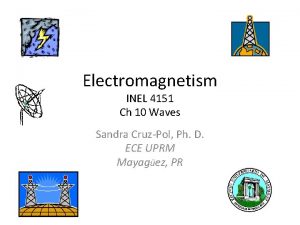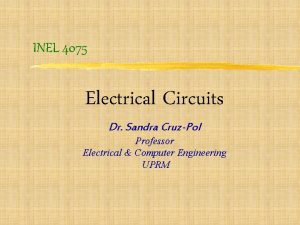Electromagnetic Theorems Principles INEL 6216 Dr Sandra XPol

















![Induction Theorem [similar to Huygen’s] • Used mostly for scattering from obstacles Induction Theorem [similar to Huygen’s] • Used mostly for scattering from obstacles](https://slidetodoc.com/presentation_image/b0f603aad4d545b26a93f71c2815250d/image-18.jpg)

- Slides: 19

Electromagnetic Theorems & Principles INEL 6216 Dr. Sandra X-Pol

Theoremas que ayudan a resolver problemas de EM • Dualidad • Unicidad • Imágenes • Reciprocidad • Equivalencia de Volumen • Equivalencia de superficie: – Principio de Huygen • Inducción

Dualidad Electric source (J) Magnetic source (M) Same mathematical form Sustematic interchange of symbols

Uniqueness theorem • Solution is unique given certain conditions: If you find two solutions, E 1 & E 2, H 1 & H 2, then over a surface S,

Image Theory • When the ground, corner reflector or other obstacle is close to a radiating element, there will be reflections from it. • This can be accounted for by image. • Earth is more lossy at high frequency and moisture • Assume ground is a perfect electric conductor, flat, and infinite in extent

Vertical (electric) Dipole Real source direct reflection h h image The direction of the Image is such that the E tangent to perfect conductor is zero.

Horizontal (electric) Dipole Real source direct reflection image The direction of the Image is such that the E tangent to perfect conductor is zero.

Electric perfect conductor electric h h magnetic sources image Infinite losser

Magnetic perfect conductor electric magnetic h sources image h Magnetic conductor

Reciprocity Theorem Related to transmitting and receiving properties of radiating systems. • Fields for sources J 1, M 1 • Fields for sources J 2, M 2 • By reciprocity then,

Volume Equivalence Th. Used to find the fields scattered by dielectric obstacles. If in free-space ( )we have: But then, the same sources find another medium ( ): We define the difference as the scattered fields:

Volume Equivalence (cont. ) Using this, we can derive: Where the volume equivalent current densities sources

Huygen's Principle • predicts the future position of a wave when its earlier position is known. “Every point on a wave front can be considered as a source of tiny wavelets that spread out in the forward direction at the speed of the wave itself. The new wave front is the envelope of all the wavelets - that is, tangent to them. "

Volume Equivalence (Huygen’s Principle) • Used mostly for aperture radiation • Here actual sources are replaced by equivalent sources (J, M) within a region to simplify solution • An imaginary closed surface is chosen (usually so that it coincides with conducting structure) but fields outside are the same. • Chosen current densities source on the surface create the same fields outside.

Perfect conductor surface Perfect magnetic conductor

Love’s Principle • If inside field are zero

Equivalent model for magnetic source radiating near perfect conductor Remove plate Solution valid only on this side
![Induction Theorem similar to Huygens Used mostly for scattering from obstacles Induction Theorem [similar to Huygen’s] • Used mostly for scattering from obstacles](https://slidetodoc.com/presentation_image/b0f603aad4d545b26a93f71c2815250d/image-18.jpg)
Induction Theorem [similar to Huygen’s] • Used mostly for scattering from obstacles

Homework problems- Ch. 7 • 5 • 11 • 13
 Pre nome
Pre nome Xpol ground tracking
Xpol ground tracking Uprm inel
Uprm inel Uprm inel
Uprm inel Anatomia membrului inferior
Anatomia membrului inferior Uprm inel
Uprm inel Uprm inel
Uprm inel Inel kayser-fleischer
Inel kayser-fleischer Uprm inel
Uprm inel Sindrom masters allen
Sindrom masters allen Uprm inel
Uprm inel Uprm inel
Uprm inel Uprm inel
Uprm inel Sandra cruz transformados
Sandra cruz transformados Trigonometry maze
Trigonometry maze Congruence theorems
Congruence theorems Conclusion on theorems of circle
Conclusion on theorems of circle Bond pricing theorems
Bond pricing theorems Circle theorems
Circle theorems Angle sum theorem
Angle sum theorem
